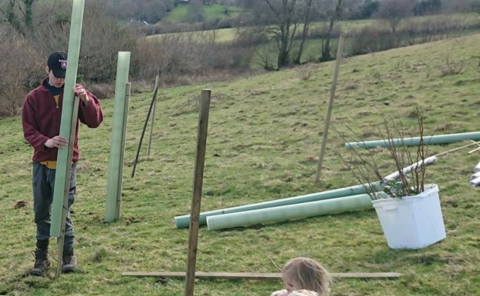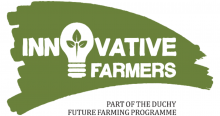What is silvopasture?
Silvopasture is a form of agroforestry where trees are deliberately planted to be part of a farms livestock system. Three tree planting designs are being trialled as part of a field lab investigating the benefits of agroforestry.
Planting trees to suit grazing requirements
Each design has been chosen to suit the grazing requirements of the farmers as well as fitting into the natural environment surrounding the chosen fields. Seven farms across Devon are testing these designs as part of 12 years of farmer led research into agroforestry. The results aim to provide the first ever set of long-term data which is practically grounded in the reality of commercial farms. This will give more farmers the confidence to plant trees into their grazing systems.
The designs have been chosen to suit a range of needs so if you are a livestock farmer there is a good chance the principles of one of these designs will suit your needs.
Design agroforestry for your farm
But what do the designs looks like? Why were they chosen? And what benefits are they hoped to bring? Three farmers below have volunteered to share the designs they worked on with the help of The Woodland Trust and FWAG Southwest.
This field lab is also partnered with Rothamsted Research and Organic Research Centre.
How open grazed clustered wood pasture fits into the farm business
Seb and Freya run an organic 100% pasture fed dairy farm near Chagford. As the farm is located on the edge of Dartmoor, parts of the land are currently very exposed to strong westerly winds. The farmers have also observed that the cows often browse on trees and lick the soil, which suggests a level of nutritional deficiency in the soil. They wanted to convert a 4.1 ha sloped field into open grazed clusters of trees and pasture providing scattered shelter throughout the field and meaning it can be used all year round. The trees also aim to provide a source of nutrition, medicine, and intestinal parasite control. As there are wilder spaces to the east of the farm this design was planned to fit into the wider natural ecosystem around it. The design was based on the principles of natural woodland succession, with a balance of native tree and shrub species chosen to suit the local landscape and provide beneficial properties to livestock.
The silvopasture design for open grazed clustered wood pasture
The design is meant to closely mimic natural regenerated wood pastures, with a fluid balance between open pasture and dense clusters of shrubs and trees. 80 clusters of trees have been planted across the field with the majority (approx. 75%) of the pasture left open.
The clusters work by planting a central core of five to ten trees such as oak, birch and aspen at a spacing of three metres. Small groups of three to five shrubs and thorns are then planted around the group of trees, like satellites around the central core. Shrub and thorn species include hazel, holly, spindle, elm, hawthorn, blackthorn and willow.
In general, the ratio of shrubs/thorns to trees is 4:1 – so in a cluster with a central core of five trees there will be a total of 20 shrubs in small groups spaced around the central core of trees. Each group of shrubs around each tree will be from a single species. So, hawthorn for one, willow for another, and so on. All tree species are to be planted with individual protection: 1.8m shelters for standard trees and 0.75m plastic spirals and canes for shrub species will be provided with trees.
The benefits of open grazed clustered wood pasture
• Tree clusters provide shelter for livestock from strong westerly winds.
• Animals can move in amongst the clusters of trees and the open pasture fluidly, grazing in shelter on both tree and pasture-based fodder. The design will allow livestock to exhibit their natural behaviour and encourage them to move across the field rather than stay in one place (e.g. under a field tree on a hot day).
• The shrubs provide plenty of access to browse which will benefit self-medication and nutrition.
• Beautiful and natural design which is best for creating attractive landscape and providing habitats for wildlife. This means it will make the most of environmental services provided by biodiverse ecosystems. The design also fits in well with landscape scale nature recovery schemes.
• Planned shelter in field provides good opportunity for over wintering dry cows and young stock.
Potential drawbacks of open grazed clustered wood pasture
• The field cannot be grazed at all until the trees are ready to withstand livestock rubbing meaning the field is expected to be out of production for between five and ten years. It is possible the field could be grazed by sheep in short bursts through the establishment period to retain agricultural activity and control scrub encroachment. If this is the case the animals need to be very closely monitored and removed as soon as they start damaging the trees.
• Sporadic design means the field is difficult cut for hay.
• Potential loss of BPS payments through the establishment period, unless the field is cut for hay or grazed carefully with sheep. However, future Environmental Land Management (ELM) schemes could reward this activity.
How many trees and shrubs in open grazed clustered wood pasture silvopasture design
| Standards Trees (% total) | No. | Shrubs (% total) | No. |
| Downy birch (10%) | 125 | Elder (5%) | 50 |
| Field maple (5%) | 50 | Elm (7.5%) | 75 |
| Oak (20%) | 225 | Hazel (7.5%) | 75 |
| Scots pine (5%) | 50 | Holly (5%) | 50 |
| Alder (5%) | 50 | Spindle (5%) | 50 |
| Aspen (5%) | 50 | Willow (12.5%) | 1603 |
| Hawthorn (7.5%) | 75 |
How much does the open grazed clustered wood pasture silvopasture design cost?
| Item | Unit |
| Total area of field (ha.) | 4.2 |
| No. of trees | 1680 |
| Fence (metres) | 0 |
| Cost of trees | £1,381.50 |
| Cost of fence | £0 |
| Total | £2326.80 |



